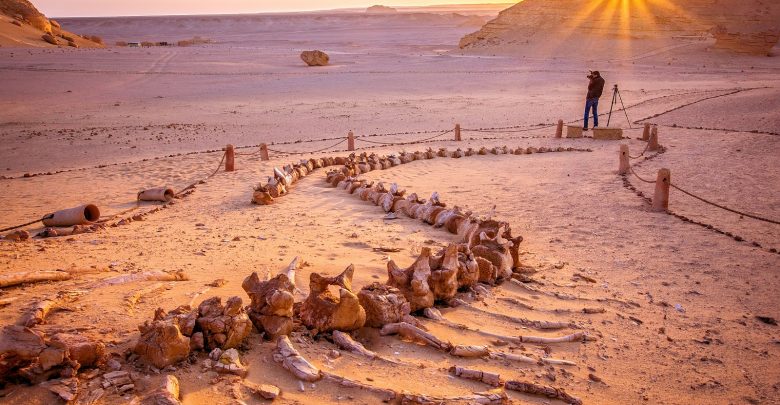This is one of the driest areas in the world, with only a few centimeters of rain a year, but the bodies of whales are emerging from the shifting sands of the Egyptian Sahara Desert. The fossilized remains are helping to reveal how much of Egypt was once covered by a vast ancient ocean around 50 million years ago.

It is known as Wadi al-Hitan, or Valley of the whales. This area contains the fossilized bones of an ancestor of modern whales that have fascinated tourists and paleontologists alike since they were first discovered in 1902.
It is now being set up like an open-air museum to show off the beasts that once swam over the area, 93 miles (150 km) southwest of Cairo. The Valley of the Whales in Egypt is home to some of the most remarkable paleontological sites on Earth due to its unusual history.

Wadi al-Hitan, or the Valley of the Whales, boasts a fascinating collection of fossils of ancient sea creatures because the area was underwater 50 million years ago at the bottom of an ocean called the Tethys Sea, which occupied the space in between Africa and Asia
Around 50 million years ago the area was at the bottom of an ocean called the Tethys Sea, which occupied the space in between Africa and Asia before India joined with the continent, pushing up the Himalayas
The whale skeletons in the region offer a glimpse into the past, as the species of whale that once called this desert valley home is now extinct. The Archaeoceti – which means ‘ancient wales’ – found in Wadi al-Hitan are some of the earliest forms of whales to emerge.
Cetaceans evolved from a land-based creature with legs, which is why many species of whale and dolphin have a phantom hip bone where the legs once attached to the body.

The whale skeletons in the region offer a glimpse into the past, as the species of whale that once called this desert valley home, the Archaeoceti, is now extinct

Tourists walk around the rocks in the natural reserve area of Wadi AL-Hitan and can see the whale fossils as they pass
Over millions of years of evolution, legs became redundant for the seafaring creatures, but some of the Archaeoceti skeletons found in Wadi al-Hitan still have their legs, complete with toes, intact.
This offers a glimpse into the evolutionary past of the whale to a time when it was still adapting to its ocean environment.
Despite whale fossils being discovered in the area over one hundred years ago, it was only made into a conservation area in the 80s, and it now acts as an open-air museum, such as the rich variety of its fossils.
Fossilized sharks, whales, and plants have allowed paleontologists to build a picture of the ancient ecology of the lost Tethys sea.
The geology of the area combines sandstone and limestone deposited by the ancient ocean with a desert landscape of sand dunes.
Over the years erosion from wind and sand has slowly revealed the fossilised skeletons trapped and preserved in the sandstone formations.
Two types of whale have been uncovered in Wadi al-Hitan, the basilosaurus, measuring up to 20 meters, and the smaller dorudon.
The Valley of the Whales is a UNESCO world heritage site.





